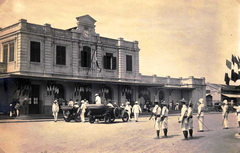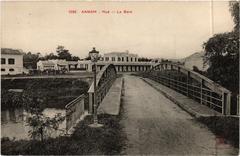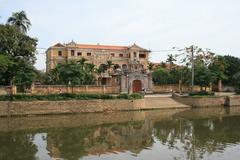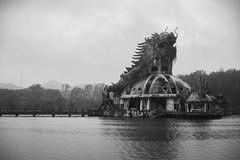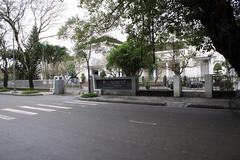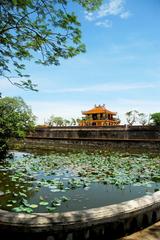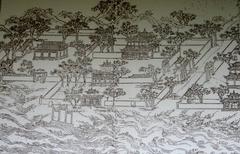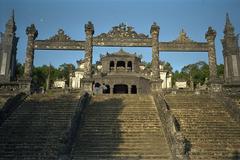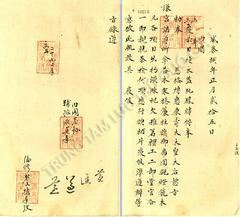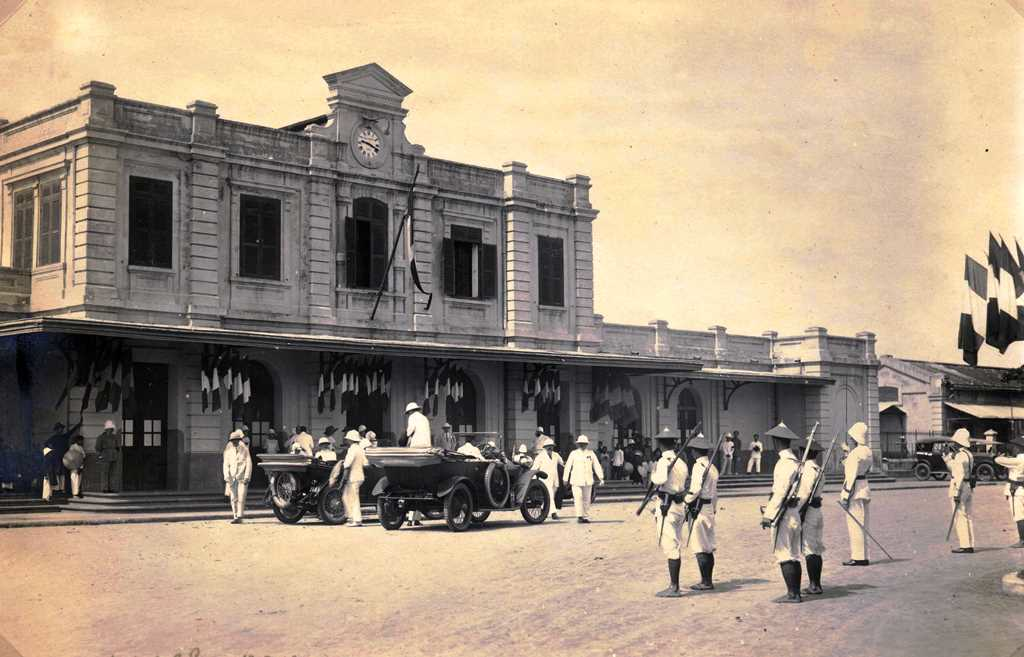
Hue Railway Station: Visitor Guide, Tickets, and Historical Insights
Date: 15/06/2025
Introduction
Hue Railway Station is far more than a transportation hub in central Vietnam; it is a living monument that captures the layered history and cultural spirit of Huế. Established during the French colonial era and situated near the UNESCO-listed Imperial City, the station embodies a blend of architectural elegance, historical resonance, and contemporary vitality. Whether you are a history enthusiast, a cultural explorer, or a traveler seeking seamless transit, Hue Railway Station offers a unique gateway to the heart of Vietnam.
This detailed guide covers everything you need to plan your visit: historical context, station architecture, visiting hours, ticketing, accessibility, nearby attractions, and practical tips. For further reading, see Vietnam Tourism, Hidden Land Travel, and MihiTravel.
Table of Contents
- Historical Overview
- Architectural Significance
- Visiting Hours and Ticketing
- Station Facilities and Accessibility
- Nearby Attractions
- Cultural Importance and Community Role
- Visitor Experience & Practical Tips
- FAQs
- Conclusion
- References
Historical Overview
Birth of the Station
Constructed in 1906, Hue Railway Station arose from the French colonial administration’s ambition to connect major Vietnamese cities via the North–South Railway (Reunification Express). The French designed the station to serve both colonial officials and the imperial court, given its proximity to the Perfume River and the Imperial City (Vietnam Tourism). The station played a pivotal role in facilitating the movement of people, goods, and ideas, deeply influencing Huế’s development.
Through War and Restoration
Hue’s strategic position made the station a focal point during the First Indochina War and the Vietnam War, suffering significant damage but always restored due to its indispensable function (MihiTravel). After reunification in 1975, initial neglect gave way to heritage preservation, recognizing the station’s architectural and historical value.
Architectural Significance
Hue Railway Station stands as a quintessential example of French colonial architecture in Vietnam. The symmetrical façade, arched windows, and tiled roof reflect early 20th-century European design, harmoniously blended with local construction techniques (Hidden Land Travel). Located at 02 Bui Thi Xuan Street, the station’s placement was historically strategic, close to the old royal elephant stables of Truong Sung.
The building retains many original features despite modern renovations, offering a photogenic setting, especially when illuminated at night (Hue Railway Station - a sense of nostalgia amidst the street). Inside, high ceilings and large windows evoke a bygone era, while murals and decorative elements add artistic appeal.
Visiting Hours and Ticketing
Visiting Hours
- Station Hours: Open daily from 4:00 AM to 10:00 PM to accommodate early and late train schedules (VietnamTrain.com).
- Ticket Office: Operates from 5:00 AM to 9:00 PM (may extend during peak travel seasons).
Ticket Purchase
- At the Station: Buy tickets directly at the left-side ticket office. Staff speak basic English.
- Online: Book in advance via Vietnam Railways, Baolau, or other reputable travel platforms (Mettavoyage).
- Via Agencies: Numerous local agencies offer ticketing, tours, and onward travel.
Ticket Classes & Prices
- Vietnam Railways: Offers hard seat, soft seat, hard sleeper (6 berths), and soft sleeper (2–4 berths), all air-conditioned.
- Private Carriages: Livitrans, Violette, Lotus, and Laman Express provide upgraded soft sleeper cabins with additional amenities. Prices range from $33–$55 for Hue–Hanoi routes (Baolau).
Advance booking is recommended, especially for high-demand routes or festival periods.
Station Facilities and Accessibility
- Waiting Areas: Clean waiting rooms with basic seating and restrooms are available. Bring tissues for restrooms.
- Food & Drink: On-site eateries serve Hue specialties, and cafés are nearby (TravelViet).
- Luggage: No official storage, but porters can assist for a small fee. Keep valuables with you.
- Accessibility: The station is single-story and mostly accessible; ramps are available, but some boarding assistance may be needed.
- Transport Links: Taxis, motorbike taxis, cyclos, and ride-hailing apps like Grab are readily available. Phu Bai Airport is about 15 km away.
Nearby Attractions
Hue Railway Station is an ideal starting point for exploring Huế’s historical and cultural treasures:
- Imperial City: 2.8 km northeast, a UNESCO World Heritage Site reflecting Vietnam’s royal history.
- Dong Ba Market: 2.5 km away, offering local cuisine and souvenirs.
- Perfume River: Within walking distance, perfect for scenic strolls or boat tours.
- Thien Mu Pagoda: Renowned Buddhist temple accessible by taxi or boat (VietnamVisa.org.vn).
Cultural Importance and Community Role
Hue Railway Station is woven into the city’s social and cultural fabric. It has witnessed arrivals and farewells of emperors, scholars, and everyday families, becoming a symbol of continuity and nostalgia (Hue Railway Station - a sense of nostalgia amidst the street). The station plays a pivotal role during events such as the Hue Festival, when it becomes a lively venue for performances and community gatherings (Vietnam Budget Car Rental).
Preservation efforts have ensured that the station retains its architectural authenticity and historic resonance, embodying Huế’s dedication to heritage and cultural identity (MihiTravel).
Visitor Experience & Practical Tips
- Best Times: Early mornings and late afternoons are busiest. Mid-morning or early afternoon offer better lighting for photography and fewer crowds.
- Local Etiquette: Respect ceremonial areas and dress modestly. Photography is welcome but do not obstruct operations.
- Health & Safety: The station is generally safe; keep an eye on your belongings. Carry bottled water and snacks if needed.
- Language: English is spoken at counters, but having your destination written in Vietnamese can help. Most signs are bilingual.
- Connectivity: Many central hotels, guesthouses, and the city center are within walking or short taxi distance.
Travel Tip: Arrive 30–45 minutes before your train. For longer waits, relax at nearby cafés or enjoy a stroll along the Perfume River.
FAQs
Q: What are Hue Railway Station’s visiting hours?
A: Open daily from 4:00 AM to 10:00 PM; ticket office from 5:00 AM to 9:00 PM.
Q: How do I buy train tickets?
A: Purchase at the ticket office, online through Vietnam Railways or Baolau, or via authorized agencies.
Q: Is the station accessible for travelers with disabilities?
A: The station has ramps and is single-story but may require assistance for boarding.
Q: What are must-see sites near the station?
A: The Imperial City, Dong Ba Market, Perfume River, and Thien Mu Pagoda.
Q: Are food options available?
A: Yes, both inside the station and at nearby cafés.
Conclusion
Hue Railway Station is a destination in its own right—a vibrant intersection of history, culture, and modern travel. As a gateway to Huế and the wider region, it welcomes visitors with its evocative colonial façade, enduring community spirit, and convenient access to the city’s greatest sights. For a rich and seamless travel experience, plan your visit with awareness of station hours, ticketing processes, and local etiquette. Download the Audiala app for current train schedules, booking, and expert travel tips, and follow our social channels for more cultural insights.
Whether you are embarking on the Reunification Express or simply soaking in Hue’s heritage, the station offers a memorable portal into Vietnam’s past and present.
References
- Vietnam Tourism
- Hidden Land Travel
- MihiTravel
- Hue Railway Station - a sense of nostalgia amidst the street
- VietnamTrain.com
- TripSavvy
- Baolau
- VietnamVisa.org.vn
- Mettavoyage
- TravelViet
- Voyage2Vietnam
- Facts and Details
- Vietnam Railways Official Website
- Vietnam Budget Car Rental
- Travelynn Family
- You in Danang
- Happy When Abroad
- The Crazy Tourist
- ConfirmGood
- Kali Travel
- WhereIsMai
- 12Go Asia
- Wikipedia
